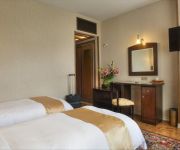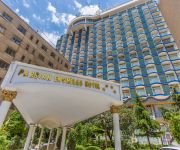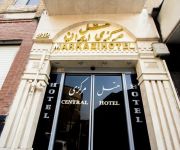Safety Score: 4,5 of 5.0 based on data from 9 authorites. Meaning please reconsider your need to travel to Iran.
Travel warnings are updated daily. Source: Travel Warning Iran. Last Update: 2024-08-13 08:21:03
Touring Bahmanyār
The district Bahmanyār of in Ostān-e Tehrān is a subburb located in Iran a little south of Tehran, the country's capital place.
Need some hints on where to stay? We compiled a list of available hotels close to the map centre further down the page.
Being here already, you might want to pay a visit to some of the following locations: Rey, Tehran, Eslamshahr, Tajrish and Shahr-e Qods. To further explore this place, just scroll down and browse the available info.
Local weather forecast
Todays Local Weather Conditions & Forecast: 15°C / 59 °F
| Morning Temperature | 12°C / 54 °F |
| Evening Temperature | 17°C / 62 °F |
| Night Temperature | 14°C / 58 °F |
| Chance of rainfall | 0% |
| Air Humidity | 26% |
| Air Pressure | 1017 hPa |
| Wind Speed | Gentle Breeze with 8 km/h (5 mph) from East |
| Cloud Conditions | Clear sky, covering 8% of sky |
| General Conditions | Sky is clear |
Monday, 18th of November 2024
15°C (58 °F)
15°C (58 °F)
Light rain, gentle breeze, scattered clouds.
Tuesday, 19th of November 2024
16°C (61 °F)
15°C (58 °F)
Light rain, gentle breeze, overcast clouds.
Wednesday, 20th of November 2024
15°C (59 °F)
16°C (61 °F)
Sky is clear, calm, clear sky.
Hotels and Places to Stay
Espinas Palace
Homa - Tehran
Ferdowsi International Grand (Hotel-e Bozorg-e Ferdowsi)
Enghelab Hotel
Howeyzeh
Shahryar Hotel
Arman
New Naderi
Pasargad Hotel
Markazi Iran
Videos from this area
These are videos related to the place based on their proximity to this place.
Tehran Wikipedia travel guide video. Created by Stupeflix.com
Create your own video on http://studio.stupeflix.com/?w=1 ! Toopkhaneh Square, Tehran, the early to mid-1900s. Azadi Square is currently the symbol of Tehran. Khalvat Karimkhani. Borj-e Sefid...
Take-Out Food Service - Tehran
Haleem and Ash-e Reshteh - Tehran. 2008. By Mehran Mehrafshan, http://xseer.com/
When Satan Rules His World
When Satan Rules His World By DEAtHtUNE Originally By DEICIDE Vocal & Bass by : Mohammad Nik Guitars by : Shahriar Hosseini Drums by : Farhad Zabolipour Mix & Mastering : DreamWave ...
Teheran - Yazd train, Iran
The outskirts of Tehran, filmed from the direct Tehran to Yazd train. Blogpost: http://reisrelaas.nl/iran-treinreis-teheran-yazd/
Inside Tehran Main Railway Station
Busy Railway Station in the evening when overnight trains leave for all directions of the country more about Iranian Railways at http://iranrail.com.
Videos provided by Youtube are under the copyright of their owners.
Attractions and noteworthy things
Distances are based on the centre of the city/town and sightseeing location. This list contains brief abstracts about monuments, holiday activities, national parcs, museums, organisations and more from the area as well as interesting facts about the region itself. Where available, you'll find the corresponding homepage. Otherwise the related wikipedia article.
Golestan Palace
Golestān Palace pronounced "Kakheh Golestān" is the former royal Qajar complex in Iran's capital city. The oldest of the historic monuments in Tehran, the Golestan Palace (also Gulistan Palace) (The Rose Garden Palace) belongs to a group of royal buildings that were once enclosed within the mud-thatched walls of Tehran’s Historic Arg (citadel).
Assembly of Experts
The Assembly of Experts (also Assembly of Experts of the Leadership) of Iran, also translated as Council of Experts, is a deliberative body of Mujtahids (Islamic scholars) that is charged with electing and removing the Supreme Leader of Iran and supervising his activities. Members of the assembly are elected from lists of candidates by direct public vote for eight-year terms. The number of members has ranged from 82 elected in 1982 to 88 elected in 2006.
Síyáh-Chál
Síyáh-Chál is the common word in Persian language for "dungeon". Historically, siyah-chals were used as a harsher form of incarceration. Typically, such dungeons had no windows or outlets, other than the entrance, consisting of a short stairway into the ground.
Shah-Abdol-Azim shrine
The Shāh Abdol Azīm Shrine, located in Rey, Iran, contains the tomb of: ‘Abdul ‘Adhīm ibn ‘Abdillāh al-Hasanī (aka. Shah Abdol Azim). Shah Abdol Azim was a fifth generation descendant of Hasan ibn ‘Alī and a companion of Muhammad al-Taqī. He was entombed here after his death in the 9th century. Adjacent to the shrine, within the complex, include the mausolea of Imamzadeh Tahir, and Imamzadeh Hamzeh (brother of the eighth Twelver Imām - Imām Reza).
Grand Bazaar, Tehran
The Grand Bazaar is a historical market situated in the capital of Iran, Tehran. A bazaar is a type of marketplace, although many - such as Tehran's Grand bazaar - fulfill additional functions rather than merely trade. Throughout its history, the Grand bazaar has played host to banks and financiers, mosques and guest houses.
National Museum of Iran
The National Museum of Iran is a museum in Tehran, Iran. It is the combination of two museums, the old Muze-ye Irân-e Bâstân ("Archaeological Museum of Iran", a break, Sasanian revival building designed by André Godard and inaugurated in 1937), and the modernistic white travertine National Arts Museum ("Mūze-i Honar-i Millī"), inaugurated in 1972.
Dar ul-Funun
Dar ul-Funun, established in 1851, was the first modern institution of higher learning in Persia.
Tughrul Tower
Tuğrul Tower (also transliterated Toghrul, Tughrol, or Tughrul) is a 12th century monument, located in the city of Rey, Iran. Tuğrul Tower is near Rashkan castle. The 20 meters tall brick tower is the tomb of Seljuk ruler Tuğrul Beg, who died in Rey in 1063. Originally, like other monuments of its time, it was capped by a conical dome, which would have added to its height. The dome collapsed during an earthquake. The thickness of the walls varies from 1.75 to 2.75 meters.
Senate of Iran
The Senate House of Iran was the upper house legislative chamber during the Pahlavi dynasty and was disbanded after the Islamic Revolution in 1979 in Iran (also known as Persia), when the legislature became unicameral. It had been established in the 1906 Persian Constitutional Revolution. Currently, the building is used by the Assembly of Experts.
Park-e Shahr
Park-e Shahr, with its 26 hectares, is a major park and also a neighbourhood located in the central part of Tehran in Iran.
Shahrara
For the neighbourhood in Kabul, see Shahrara, Afghanistan Shahrara is a neighbourhood in north-west Tehran, the capital city of Iran. It is centred on the park bounded by Shahrara square (incorrectly filed as Shahr Asa by Google) and can be found at Google Maps.
Ibn Babawayh Cemetery
Ebn-e Babooyeh cemetery, Ebn-e Babveyh, or Ibn-e Baabevey is located in Iran in the town of Rey (now inside Greater Tehran metropolitan area). The cemetery is named after the most famous occupant, Ibn Babawayh (d.991 CE) a famous scholar of Shia Islam. He taught in Baghdad and lived in Rey at the end of his life. His works (more than 300 volumes) are used as valid sources in Jurisprudence. His most famous book is Man La-yahzar al-faqih. He died in 381 A.H. and his tomb is in Ebn-e Babooyeh.
Reza Shah's mausoleum
Reza Shah's Mausoleum, located in Ray south of Tehran, was the burial ground of Reza Shah, the penultimate king of Iran. In the early days of the Iranian Revolution in February 1979, Reza Shah's mausoleum was destroyed under the direction of Ayatollah Sadeq Khalkhali; the act was approved by Ruhollah Khomeini. In his memoires, Khalkhali describes how difficult it was to destroy the building.
Shahr-e-Rey Metro Station
Shahr-e-Rey Metro Station is a station in Tehran Metro Line 1. It is located in Shahr-e-Rey. It is between Fath Abad Metro Station and Javanmard-e-Ghassab Metro Station.
Javanmard-e-Ghassab Metro Station
Javanmard-e-Ghassab Metro Station is a station in Tehran Metro Line 1. It is located in Shahid Dastvare Boulevard. It is between Shahr-e-Rey Metro Station and Ali Abad Metro Station.
Ali Abad Metro Station
Ali Abad Metro Station is a station in Tehran Metro Line 1. It is located in Shahid Dastvare Boulevard. It is between Javanmard-e-Ghassab Metro Station and Khazane Metro Station.
Khazane Metro Station
Khazaneh Metro Station is a station in Tehran Metro Line 1. It is between Ali Abad Metro Station and Terminal-e Jonub Metro Station.
Terminal-e Jonub Metro Station
Terminal-e Jonub Metro Station is a station in Tehran Metro Line 1. It is located in Tehran southern Bus Terminal. It is between Khazane Metro Station and Shush Metro Station.
Shush Metro Station
Shush Metro Station is a station in Tehran Metro Line 1. It is located in Shush Square. It is between Terminal-e Jonub Metro Station and Molavi Metro Station. Route 5 of the Tehran trolleybus system serves Meydan-e-Shush (Shush Square) and thus connects with the metro system at this station.
Molavi Metro Station
Molavi Metro Station is a station in Tehran Metro Line 1. It is located in Mohammadiye Square, junction of Khayam Street and Molavi Street. It is between Shush Metro Station and Khayam Metro Station.
Khayam Metro Station
Khayyam Metro Station is a station in Tehran Metro Line 1. It is located in Khayam Street. It is between Molavi Metro Station and Panzdah-e-Khordad Metro Station.
Panzdah-e-Khordad Metro Station
15th of Khordad Metro Station is a station in Tehran Metro Line 1. It is located in Panzdah-e Khordad Square, junction of Khayam Street and Panzdah-e-Khordad Street. It is between Khayam Metro Station and Imam Khomeini Metro Station.
Takia-ye Dawlat
Takia-ye Dawlat or Takiyeh-e Dowlat was a Royal Theater in Tehran, Iran. It was the most famous of all the ta'zieh performance spaces, for the Mourning of Muharram. It has a capacity for more than 4,000 people. Built in 1868 by Naser al-Din Shah Qajar south-east of the Golestan Palace on the site of the Síyáh-Chál, the Royal Theater's sumptuous magnificence surpassed that of Europe's greatest opera houses in the opinion of many Western visitors.
Tehran peace museum
The Tehran Peace Museum is a member of the International Network of Museums for Peace. The main objective of the museum is to promote a culture of peace through raising awareness about the devastating consequences of war, with a focus on the health and environmental impacts of Chemical weapons. Currently housed in a building donated by the municipality of Tehran within the historic City Park, the Tehran Peace Museum is as much an interactive peace center as a museum.
Tehran Railway Station
Tehran railway station is located in Rahahan Square, at the foot of Valiasr Street in the southern part of Tehran, Iran. The building was constructed in 1930 by a German engineer.























